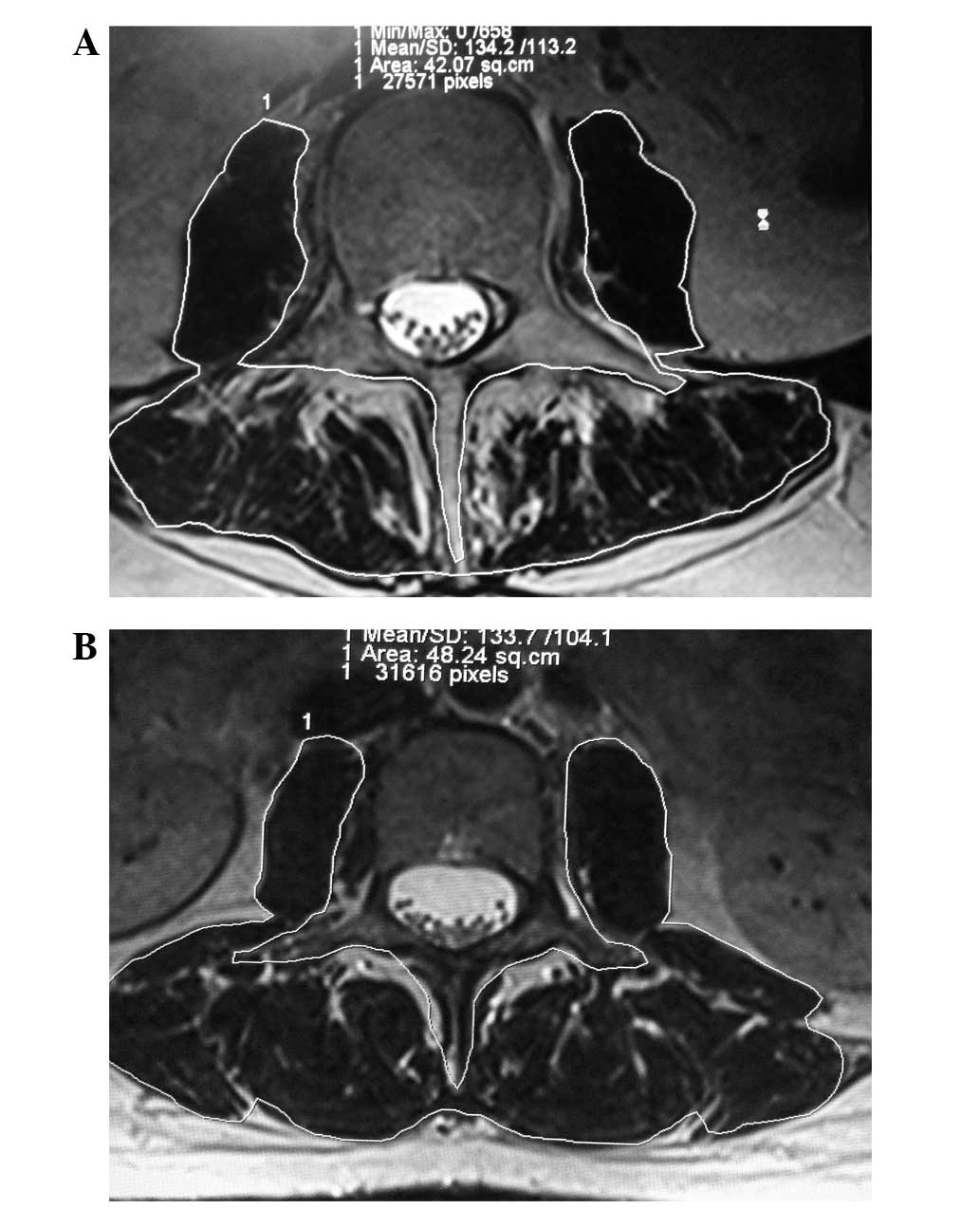|
1
|
Ryall JG, Schertzer JD and Lynch GS:
Cellular and molecular mechanisms underlying age-related skeletal
muscle wasting and weakness. Biogerontology. 9:213–228. 2008.
View Article : Google Scholar : PubMed/NCBI
|
|
2
|
Visser M: Towards a definition of
sarcopenia - results from epidemiologic studies. J Nutr Health
Aging. 13:713–716. 2009. View Article : Google Scholar : PubMed/NCBI
|
|
3
|
Cruz-Jentoft AJ, Baeyens JP, Bauer JM,
Boirie Y, Cederholm T, Landi F, Martin FC, Michel JP, Rolland Y,
Schneider SM, et al: European Working Group on Sarcopenia in Older
People: Sarcopenia: European consensus on definition and diagnosis:
Report of the European working group on sarcopenia in older people.
Age Ageing. 39:412–423. 2010. View Article : Google Scholar : PubMed/NCBI
|
|
4
|
Mitchell WK, Williams J, Atherton P,
Larvin M, Lund J and Narici M: Sarcopenia, dynapenia, and the
impact of advancing age on human skeletal muscle size and strength;
a quantitative review. Front Physiol. 3:2602012. View Article : Google Scholar : PubMed/NCBI
|
|
5
|
Tisdale MJ: Pathogenesis of cancer
cachexia. J Support Oncol. 1:159–168. 2003.PubMed/NCBI
|
|
6
|
Janssen I, Shepard DS, Katzmarzyk PT and
Roubenoff R: The healthcare costs of sarcopenia in the United
States. J Am Geriatr Soc. 52:80–85. 2004. View Article : Google Scholar : PubMed/NCBI
|
|
7
|
Wingo PA, Ries LA, Rosenberg HM, Miller DS
and Edwards BK: Cancer incidence and mortality, 1973-1995: A report
card for the U.S. Cancer. 82:1197–1207. 1998. View Article : Google Scholar : PubMed/NCBI
|
|
8
|
Brenner H: Long-term survival rates of
cancer patients achieved by the end of the 20th century: A period
analysis. Lancet. 360:1131–1135. 2002. View Article : Google Scholar : PubMed/NCBI
|
|
9
|
Gutierrez EG, Banks WA and Kastin AJ:
Murine tumor necrosis factor alpha is transported from blood to
brain in the mouse. J Neuroimmunol. 47:169–176. 1993. View Article : Google Scholar : PubMed/NCBI
|
|
10
|
DeWys WD: Anorexia as a general effect of
cancer. Cancer 43 (Suppl). 2013–2019. 1979. View Article : Google Scholar
|
|
11
|
Reeds PJ, Fjeld CR and Jahoor F: Do the
differences between the amino acid compositions of acute-phase and
muscle proteins have a bearing on nitrogen loss in traumatic
states? J Nutr. 124:906–910. 1994.PubMed/NCBI
|
|
12
|
Deans DA, Wigmore SJ, Gilmour H,
Paterson-Brown S, Ross JA and Fearon KC: Elevated tumour
interleukin-1beta is associated with systemic inflammation, A
marker of reduced survival in gastro-oesophageal cancer. Br J
Cancer. 95:1568–1575. 2006. View Article : Google Scholar : PubMed/NCBI
|
|
13
|
Fearon KC: TheS ir David Cuthbertson Medal
Lecture 1991. Histopathology. Proc Nutr Soc. 51:251–265. 1992.
View Article : Google Scholar : PubMed/NCBI
|
|
14
|
Bryant D, Becker L, Richardson J, Shelton
J, Franco F, Peshock R, Thompson M and Giroir B: Cardiac failure in
transgenic mice with myocardial expression of tumor necrosis
factor-alpha. Circulation. 97:1375–1381. 1998. View Article : Google Scholar : PubMed/NCBI
|
|
15
|
Ramos EJ, Suzuki S, Marks D, Inui A,
Asakawa A and Meguid MM: Cancer anorexia-cachexia syndrome,
Cytokines and neuropeptides. Curr Opin Clin Nutr Metab Care.
7:427–434. 2004. View Article : Google Scholar : PubMed/NCBI
|
|
16
|
Donohoe CL, Ryan AM and Reynolds JV:
Cancer cachexia, Mechanisms and clinical implications.
Gastroenterol Res Pract. 2011:6014342011. View Article : Google Scholar : PubMed/NCBI
|
|
17
|
Mourtzakis M, Prado CM, Lieffers JR,
Reiman T, McCargar LJ and Baracos VE: A practical and precise
approach to quantification of body composition in cancer patients
using computed tomography images acquired during routine care. Appl
Physiol Nutr Metab. 33:997–1006. 2008. View
Article : Google Scholar : PubMed/NCBI
|
|
18
|
Shen W, Punyanitya M, Wang Z, Gallagher D,
St-Onge MP, Albu J, Heymsfield SB and Heshka S: Total body skeletal
muscle and adipose tissue volumes, Estimation from a single
abdominal cross-sectional image. J Appl Physiol (1985).
97:2333–2338. 2004. View Article : Google Scholar : PubMed/NCBI
|
|
19
|
Bosaeus I, Daneryd P, Svanberg E and
Lundholm K: Dietary intake and resting energy expenditure in
relation to weight loss in unselected cancer patients. Int J
Cancer. 93:380–383. 2001. View
Article : Google Scholar : PubMed/NCBI
|
|
20
|
Antoun S, Baracos VE, Birdsell L, Escudier
B and Sawyer MB: Low body mass index and sarcopenia associated with
dose-limiting toxicity of sorafenib in patients with renal cell
carcinoma. Ann Oncol. 21:1594–1598. 2010. View Article : Google Scholar : PubMed/NCBI
|
|
21
|
Prado CM, Lieffers JR, McCargar LJ, Reiman
T, Sawyer MB, Martin L and Baracos VE: Prevalence and clinical
implications of sarcopenic obesity in patients with solid tumours
of the respiratory and gastrointestinal tracts, A population-based
study. Lancet Oncol. 9:629–635. 2008. View Article : Google Scholar : PubMed/NCBI
|
|
22
|
Poortmans JR, Carpentier A, Pereira-Lancha
LO and Lancha A Jr: Protein turnover, amino acid requirements and
recommendations for athletes and active populations. Braz J Med
Biol Res. 45:875–890. 2012. View Article : Google Scholar : PubMed/NCBI
|
|
23
|
Pahor M and Kritchevsky S: Research
hypotheses on muscle wasting aging, loss of function and
disability. J Nutr Health Aging. 2:97–100. 1998.PubMed/NCBI
|
|
24
|
Williams JP, Phillips BE, Smith K,
Atherton PJ, Rankin D, Selby AL, Liptrot S, Lund J, Larvin M and
Rennie MJ: Effect of tumor burden and subsequent surgical resection
on skeletal muscle mass and protein turnover in colorectal cancer
patients. Am J Clin Nutr. 96:1064–1070. 2012. View Article : Google Scholar : PubMed/NCBI
|
|
25
|
Akbulut G: New perspective for nutritional
support of cancer patients: E nteral/parenteral nutrition. Exp Ther
Med. 2:675–684. 2011.PubMed/NCBI
|
|
26
|
Santarpia L, Contaldo F and Pasanisi F:
Nutritional screening and early treatment of malnutrition in cancer
patients. J Cachexia Sarcopenia Muscle. 2:27–35. 2011. View Article : Google Scholar : PubMed/NCBI
|










